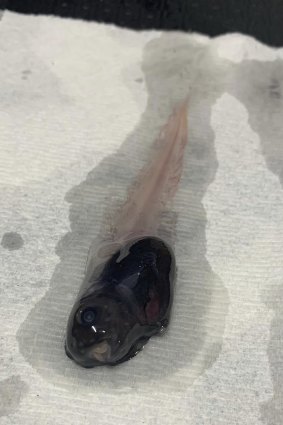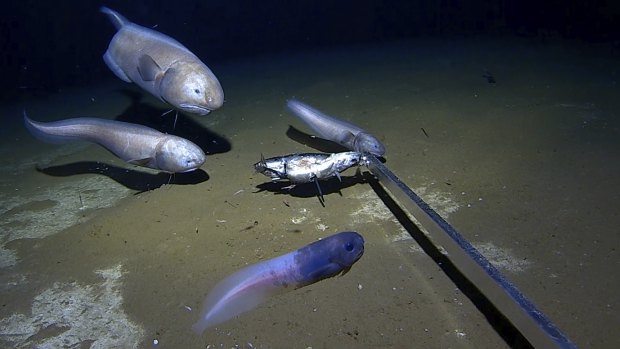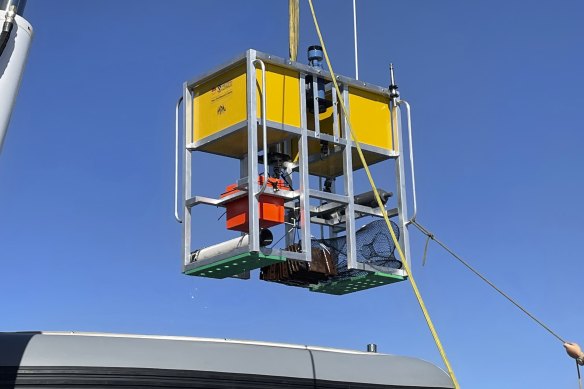- Exclusive
- Environment
- Conservation
- Marine life
This was published 2 years ago
Scientists land deepest fish ever caught off Australia from 6.5km below
Marine researchers have landed the deepest fish ever caught off Australia from 6.5 kilometres underwater using a yabby trap, bought from a Perth tackle shop, tied to a $100,000 piece of scientific monitoring equipment resistant to extreme pressure.
The two new unnamed species of snailfish have faces frozen in a frown like a sad clown and bodies made of translucent gel instead of skin and scales.
The fish, which were between 10 and 25 centimetres long, were captured on camera and in the traps on the second expedition by the recently formed Minderoo-University of Western Australia Deep-Sea Research Centre to better understand the underexplored Indian Ocean through mapping and surveys.
Researchers used billionaire Andrew Forrest’s boat the Pangea Ocean Explorer for the trip to the south-eastern Indian Ocean to explore the bottom of the Diamantina Fracture Zone, an area of ridges and trenches which get as deep as 7100 metres, off Western Australia.

The snailfish’s skin is gelatinous and therefore starts cooking when brought up to warmer temperatures.Credit: UWA
The deepest part of the Indian Ocean is about 7200 metres down in the Sunda Trench near Sumatra.
Other species of snailfish have been recorded as far down as 8100 metres in the deepest place on the planet the Mariana Trench in the Pacific Ocean.
The two new species were caught using deep-sea landers, metal frames carrying recording equipment, which took 2.5 hours to drop down to a depth of 6500 metres off the side of the Pangea.
Landers rested on the pitch-black ocean floor for about eight hours measuring oxygen, salinity and videoing marine life that becomes attracted to bait.
Deep-Sea Research Centre founding director and UWA Professor Alan Jamieson said a few yabby traps were also attached.
“I think the traps were $30. The vehicle itself was like $100,000,” he said.

An unnamed snailfish with a dark-coloured head is photographed 6000 metres below the Indian Ocean’s surface. Cusk-eels gather in the background.Credit: UWA/Minderoo
Jamieson said once the snailfish were brought to the surface they did not have much time to work with the peculiar animal, which started melting because of the dramatic temperature change going to the surface compared to the 2 degrees it lived in.
“While the fish are in the trap they are basically being cooked because they haven’t ever been to 25 degrees in the last 10 million years,” he said.
“Once they come on board you have probably less than 20 minutes to preserve it. You can’t put it on the desk and photograph it for ages because it literally starts to fall apart in front of your very eyes because of the temperature.
“They are kind of strange little things, they’re not what you imagine. A lot of people think deep-sea fish are going to be some big crazy thing, bioluminescent, big teeth and all the rest of it ... the deep-sea fish tend to be sort of bigger and a bit sadder looking.”

A deep-sea lander complete with a yabby trap.Credit: UWA/Minderoo
It could be years before the two fish are scientifically described and Jamieson already has two other unnamed snailfish from other parts of the world taking up space in his freezer.
For the broader effort of Indian Ocean exploration, the new snailfish provide another data point in understanding its unique ecosystems like the massive fields of manganese nodules – eight-million-year old metal-rich stones found between depths of 4000 and 6000 metres.
Jamieson said very little of the oceans off Australia had been explored beyond 500 metres down.
But with advancements in technology researchers could push further below the surface and were collecting data faster than they could publish.
“Ten or 15 years ago we would go out and do two deployments of a camera and that would be considered a massive success and now we’re looking at doing up to 20 a week,” Jamieson said.
Jamieson’s next trip is to Japan, where his team hopes to determine the age of deep-sea fish by trying to detect particles which could be linked to the Fukushima nuclear disaster in ear bones.
A guide to the environment, what’s happening to it, what’s being done about it and what it means for the future. Sign up to our fortnightly Environment newsletter here.